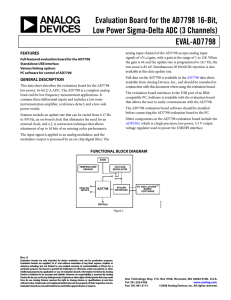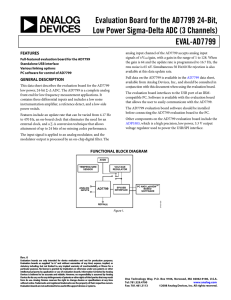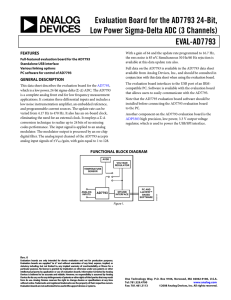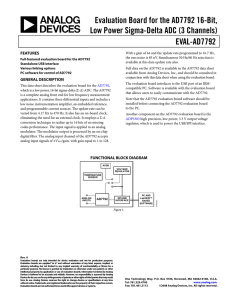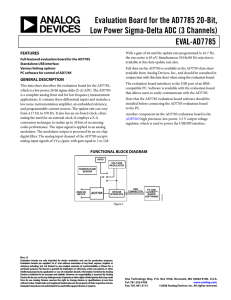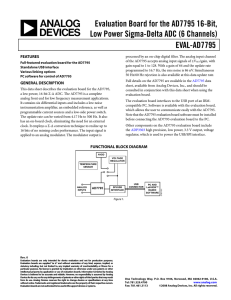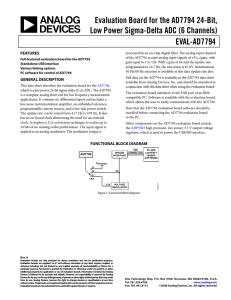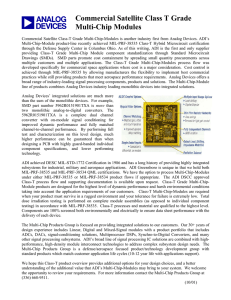EVAL-AD7714-3EBZ User Guide UG-761
advertisement
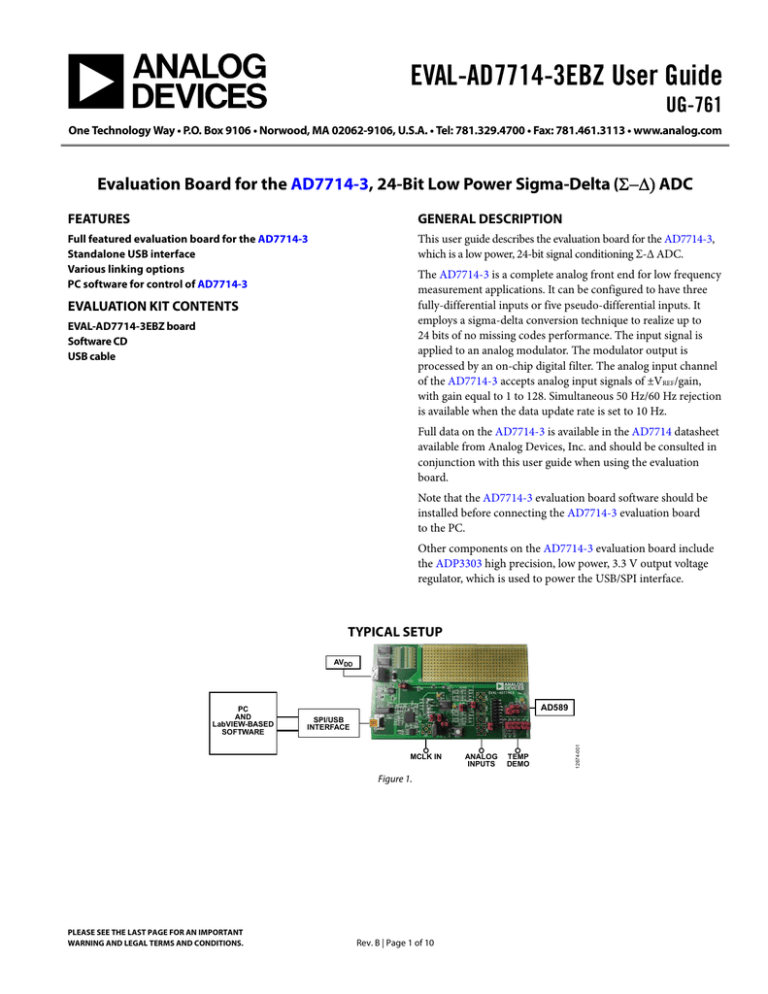
EVAL-AD7714-3EBZ User Guide UG-761 One Technology Way • P.O. Box 9106 • Norwood, MA 02062-9106, U.S.A. • Tel: 781.329.4700 • Fax: 781.461.3113 • www.analog.com Evaluation Board for the AD7714-3, 24-Bit Low Power Sigma-Delta ( ADC FEATURES GENERAL DESCRIPTION Full featured evaluation board for the AD7714-3 Standalone USB interface Various linking options PC software for control of AD7714-3 This user guide describes the evaluation board for the AD7714-3, which is a low power, 24-bit signal conditioning Σ-Δ ADC. The AD7714-3 is a complete analog front end for low frequency measurement applications. It can be configured to have three fully-differential inputs or five pseudo-differential inputs. It employs a sigma-delta conversion technique to realize up to 24 bits of no missing codes performance. The input signal is applied to an analog modulator. The modulator output is processed by an on-chip digital filter. The analog input channel of the AD7714-3 accepts analog input signals of ±VREF/gain, with gain equal to 1 to 128. Simultaneous 50 Hz/60 Hz rejection is available when the data update rate is set to 10 Hz. EVALUATION KIT CONTENTS EVAL-AD7714-3EBZ board Software CD USB cable Full data on the AD7714-3 is available in the AD7714 datasheet available from Analog Devices, Inc. and should be consulted in conjunction with this user guide when using the evaluation board. Note that the AD7714-3 evaluation board software should be installed before connecting the AD7714-3 evaluation board to the PC. Other components on the AD7714-3 evaluation board include the ADP3303 high precision, low power, 3.3 V output voltage regulator, which is used to power the USB/SPI interface. TYPICAL SETUP AVDD AD7714-3 AD589 SPI/USB INTERFACE MCLK IN Figure 1. PLEASE SEE THE LAST PAGE FOR AN IMPORTANT WARNING AND LEGAL TERMS AND CONDITIONS. Rev. B | Page 1 of 10 ANALOG INPUTS TEMP DEMO 12674-001 PC AND LabVIEW-BASED SOFTWARE UG-761 EVAL-AD7714-3EBZ User Guide TABLE OF CONTENTS Features .............................................................................................. 1 Setup Conditions ...........................................................................5 Evaluation Kit Contents ................................................................... 1 Sockets ............................................................................................5 General Description ......................................................................... 1 Push-Button Reset .........................................................................5 Typical Setup ..................................................................................... 1 How to Use the Software ..................................................................6 Revision History ............................................................................... 2 Software Description ....................................................................6 Getting Started .................................................................................. 3 Using the Software ........................................................................6 Software Install Procedures ......................................................... 3 Main Window (Registers Window) ............................................7 Evaluation Board Setup Procedures........................................... 3 Cal Registers Window ..................................................................8 Evaluation Board Hardware ............................................................ 4 Temp Demo Window ...................................................................9 Power Supplies .............................................................................. 4 Related Links ................................................................................... 10 Links ............................................................................................... 4 REVISION HISTORY 12/14—Rev. A to Rev. B Updated Format .................................................................. Universal Changes to Features Section, General Description Section, and Figure 1 ....................................................................................... 1 Added Evaluation Kit Contents Section ........................................ 1 Added Getting Started Section ....................................................... 2 Deleted SKT1 Section ...................................................................... 3 Changes to Evaluation Board Hardware Section ......................... 4 Changes to How to Use the Software Section ............................... 6 Deleted Figure 3 ................................................................................ 6 Deleted Component Listing and Manufacturers Section............ 7 Added Related Links Section ........................................................ 10 Rev. B | Page 2 of 10 EVAL-AD7714-3EBZ User Guide UG-761 GETTING STARTED Because the board is powered via the USB connector, there is no need for an external power supply, although if preferred one may be connected via J3. SOFTWARE INSTALL PROCEDURES Use the following steps to install the software: 1. 2. 3. 4. Start Windows® and insert the CD. The installation software should launch automatically. If it does not, use Windows Explorer to locate the setup.exe file on the CD. Double-click this file to start the installation procedure. At the prompt, select a destination directory, which is C:\Program Files\Analog Devices\AD7714-3 by default. Once the directory is selected, the installation procedure copies the files into the relevant directories on the hard drive. The installation program creates a program group called Analog Devices with a subgroup AD7714-3 in the Start menu of the taskbar. Communication between the AD7714-3 and the PC is via the USB/SPI interface. The on-board USB controller (U2) controls this communication. To set up the USB/SPI interface, use the following procedure: 1. 2. Once the installation procedure is complete, double-click the AD7714-3 icon to start the program. EVALUATION BOARD SETUP PROCEDURES 3. 12674-002 Interfacing to the evaluation board is via a standard USB connector, J1. J1 is used to connect the evaluation board to the USB port of a PC. A standard USB connector cable is included with the AD7714-3 evaluation board to allow the evaluation board to interface with the USB port of the PC. Install the AD7714-3 evaluation board software using the supplied AD7714-3 evaluation board CD before connecting the board to the PC. After the AD7714-3 evaluation board software has been installed, connect the board to the PC via J1 on the AD7714-3 evaluation board and via the USB port on the PC using the supplied USB connector cable (see Figure 1). The PC automatically finds the new USB device and identifies it as the AD779x Evaluation Board (see Figure 2). Follow the on-screen instructions that appear. During the installation process if the Hardware Installation Wizard appears as shown in Figure 2, select Continue Anyway to successfully complete the installation of the AD7714-3 evaluation board. Figure 2. Hardware Installation Window Rev. B | Page 3 of 10 UG-761 EVAL-AD7714-3EBZ User Guide EVALUATION BOARD HARDWARE POWER SUPPLIES LINKS The AD7714-3 evaluation board is powered via the 5 V supply from the USB connector, J1. This 5 V supply can be used to power the AD7714-3 directly. A 3.3 V regulated voltage from the on-board ADP3303 (a high precision, low power, 3.3 V output voltage regulator) can also be used. Alternatively, the AD7714-3 can be powered using an external 3 V or 5 V power supply via J3. There are fifteen link options that must be set for the required operating setup before using the evaluation board. The functions of these link options are outlined in Table 1. Table 1. Evaluation Board Link Settings Link LK1 Default In LK2 In LK3, LK4 LK5, LK6, LK7 Out LK8, LK9 In LK10 A LK11 A LK12 A LK13, LK14 In LK15 B Description This link is used to externally short the AIN1 input channel to the reference. With LK1 and LK2 in place, Pin AIN1 is shorted to Pin AIN2 and both are biased at REFIN+. This allows a noise analysis to be performed. With this link out, an external voltage may be applied to AIN1 using the SMB connectors. This link is used to short Pin AIN1 to Pin AIN2. When both LK1 and LK2 are inserted, noise analysis can be performed. With this link out, an external voltage can be applied to AIN2 using the SMB connectors. These links are used to connect the on-board temperature demonstration circuit to the ADC, and must all be in place when attempting to measure ambient temperature. When the on-board temperature demonstration circuit is selected in software, LK7, when in place, connects AVDD to the temperature demonstration circuit. LK4 and LK5 when in place connect the 1 kΩ thermistor to the AIN1 − AIN2 analog input channel, and with LK2 and LK3 in place a ratiometric configuration of the temperature demonstration circuit is in place. These links are used to connect the AD589 reference to the AD7714-3. When both links are in place, the 1.23 V generated by the band gap reference is used as the reference source to the AD7714-3. When these links are removed, another reference source can be applied to the AD7714-3 using the SMB connectors. LK8 and LK9 need to be removed when the temperature demonstration is operated. LK10 is used to select the polarity of the AD7714-3 SCLK. With LK10 in Position A, POL is connected to DVDD so that data is output on the SCLK falling edge. With LK10 in Position B, POL is connected to AGND and data is output from the AD7714-3 on the SCLK rising edge. LK11 controls the STANDBY pin of the AD7714-3. With LK11 in Position A, STANDBY is pulled high and the AD7714-3 is powered up. With LK11 in Position B, STANDBY is pulled low and the AD7714-3 is placed in power-down mode. LK12 is used to enable or disable the AD7714-3 analog input buffers. With LK12 in Position A, the pin BUFFER is tied high and the analog inputs of the AD7714-3 are buffered. With LK12 in Position B, the BUFFER pin is tied low and the analog inputs of the AD7714-3 are unbuffered. LK13 and LK14 are used to connect the 2.4576 MHz crystal to the AD7714-3. When these links are in place, the on-board crystal is connected to the AD7714-3. When these links are removed, an external clock source can be applied to the AD7714-3 via the SMB connector. LK15 is used to select the power source for AVDD on the AD7714-3. LK15 in Position A selects an external power supply, supplied via J3. LK15 in Position B selects the 3.3 V regulated output from the on-board ADP3303 voltage regulator. Rev. B | Page 4 of 10 EVAL-AD7714-3EBZ User Guide UG-761 SETUP CONDITIONS PUSH-BUTTON RESET Ensure that all link positions are set per the required operating mode before applying power and signals to the evaluation board. There is also a push-button switch on the evaluation board, which is used to perform a reset. When the button is pressed, the RESET pin of the AD7714-3 is tied to ground and the AD7714-3 registers are set to their default conditions. Table 2 shows the position in which all the links are initially set. SOCKETS There are six sockets relevant to the operation of the AD7714-3 on this evaluation board. The functions of these sockets are outlined in Table 3. Table 2. Initial Link and Switch Positions Link No. LK1 LK2 LK3, LK4 LK5, LK6 LK7 LK8, LK9 LK10 LK11 LK12 LK13, LK14 LK15 Position In In Out Out Out In A A A In B Function AIN1 is connected to REFIN+. AIN2 is shorted to AIN1. The temperature demo is not connected to AIN1 − AIN2. The reference pins of the AD7714-3 are not connected to the temperature demonstration. AVDD is not connected to temperature demo circuit. The AD589 is used as the reference source to the AD7714-3. POL is pulled high so data is output on the SCLK falling edge. The AD7714-3 is powered up. The analog inputs are operated in buffered mode. The 2.4576 MHz crystal is used as the clock source to the AD7714-3. The 3.3 V regulated voltage is used as the power supply to the AD7714-3 and the AD589. Table 3. Socket Functions Socket AIN1 AIN2 REFIN+ REFIN− CLK J2 Function Subminiature BNC (SMB) connector. The analog input signal for the AIN1 input of the AD7714-3 is applied to this socket. Subminiature BNC (SMB) connector. The analog input signal for the AIN2 input of the AD7714-3 is applied to this socket. Subminiature BNC (SMB) connector. This socket is used in conjunction with REFIN− to apply an external reference to the AD7714-3. The voltage for the REFIN+ input of the AD7714-3 is applied to this socket. Subminiature BNC (SMB) connector. This socket is used in conjunction with REFIN+ to apply an external reference to the AD7714-3.The voltage for the REFIN− input of the AD7714-3 is applied to this socket. Subminiature BNC (SMB) connector. An external clock source can be applied to the AD7714-3 using this socket. 16-pin (2×8) pin straight header. This socket is used in conjunction with the prototype area to interface any signal to the AD7714-3. Rev. B | Page 5 of 10 UG-761 EVAL-AD7714-3EBZ User Guide HOW TO USE THE SOFTWARE SOFTWARE DESCRIPTION USING THE SOFTWARE The AD7714-3 evaluation board is shipped with a CD containing software that can be installed onto a standard PC to control the AD7714-3. The software communicates with the AD7714-3 through the USB cable, which accompanies the board. The software allows you to configure the AD7714-3 and to read conversion data from the AD7714-3. Data can be read from the AD7714-3 and displayed or stored for later analysis. For further information, see the AD7714-3 data sheet available from Analog Devices. Figure 3 shows the main window that is displayed when the program starts. The Main Window (Registers Window) section briefly describes the various menu and button options on the main window. The Cal Registers Window and Temp Demo Window sections describe the most commonly used evaluation software windows. The data that has been read can be exported to other packages such as MathCAD™ or Microsoft® Excel for further analysis. During power-up, the AD7714-3 evaluation board software configures the device to have a gain of 1, the AIN1/AIN2 channel is selected, the update rate is set to 60 Hz and the word length is set to 24. Figure 3. AD7714-3 Evaluation Software Main Window Rev. B | Page 6 of 10 EVAL-AD7714-3EBZ User Guide UG-761 MAIN WINDOW (REGISTERS WINDOW) Registers Menu Bar File The Registers button selects the main window which allows the user access to the mode register and the filter high/low registers. This window allows you to change items such as polarity, update rate, and gain. Consult the AD7714-3 data sheet for further details on the bit functions. The File menu allows the user to read previously stored data for display or analysis, write the current set of data to a file for later use, and exit the program. About Cal Registers The Cal Registers button allows the user to access the offset register and full-scale register. The About menu provides information on the revision of software used. Temp Demo Buttons Reset The Reset button allows the user to reset the AD7714-3 and set the registers to the power up conditions as specified by the software (channel = AIN1/AIN2, gain = 1, update rate = 60 Hz). Exit The Exit button allows the user to exit the software. It serves the same purpose as Quit in the File pull-down menu. Sample The Sample button allows the user to read a number of samples from the AD7714-3. Noise analysis is then performed on the samples. These samples can be stored for further analysis. The sample size is entered in the Num Samples text box. Continuous The Continuous button allows the user to read a number of samples continuously. The software gathers a number of samples as specified by the Num Samples text box, performs noise analysis on the samples, and then gathers the next group of samples. The Temp Demo button allows the user to access the temperature demonstration software. Waveform The Waveform button gathers conversions and displays them in graph form. Histogram The Histogram button gathers samples are uses them to generate a histogram. Codes The Codes button gathers samples and can display them in codes or in voltage format. When the Codes option is selected, the values are displayed as code. The Codes button changes to Volts. To display the information in volts, click Volts. Reference The value of the external reference should be entered in the Reference text box. Rev. B | Page 7 of 10 UG-761 EVAL-AD7714-3EBZ User Guide CAL REGISTERS WINDOW Click Cal Registers to access the Cal Registers window (see Figure 4). This window displays the contents of the offset calibration register and the full-scale calibration register. Figure 4. AD7714-3 Evaluation Software Cal Registers Window Rev. B | Page 8 of 10 EVAL-AD7714-3EBZ User Guide UG-761 TEMP DEMO WINDOW Click Temp Demo to access the temperature demonstration window (see Figure 5). The AD7714-3 evaluation board has a temperature demonstration included on the board. To operate the temperature demonstration, LK3 to LK7 should be inserted and LK1, LK2, LK9, and LK12 should be removed. With these links in place, AVDD is connected to a 1 kΩ thermistor which is connected across the AIN1/AIN2 pins. In series with the thermistor is a 5 kΩ precision resistor, which is used to generate the reference voltage so that a ratio metric configuration is used. The temperature demonstration software saves the values in the mode register, filter high/low registers, offset register, and full scale register. The software then configures the AD7714-3 to operate with a gain of 1, the AIN1/AIN2 channel is selected as the analog input, and the update rate is set to 60 Hz. When you select Run, the software continuously reads the conversion from the AIN1/AIN2 channel and converts the result to temperature using a look-up table. When Run is clicked again, the temperature demonstration execution is halted. To exit the temperature demonstration, click the Back button. The software sets the mode register, filter registers, and calibration registers to their previous values. Figure 5. AD7714-3 Evaluation Software Temperature Demo Window Rev. B | Page 9 of 10 UG-761 EVAL-AD7714-3EBZ User Guide RELATED LINKS Resource AD7714-3 ADP3303 AD589 Description Product Page, CMOS, 3 V/5 V, 24-Bit Sigma-Delta Conditioning ADC Product Page, High Accuracy anyCAP 200 mA Low Dropout Linear Regulator Product Page, Two-Terminal IC 1.2 V Reference ESD Caution ESD (electrostatic discharge) sensitive device. Charged devices and circuit boards can discharge without detection. Although this product features patented or proprietary protection circuitry, damage may occur on devices subjected to high energy ESD. Therefore, proper ESD precautions should be taken to avoid performance degradation or loss of functionality. Legal Terms and Conditions By using the evaluation board discussed herein (together with any tools, components documentation or support materials, the “Evaluation Board”), you are agreeing to be bound by the terms and conditions set forth below (“Agreement”) unless you have purchased the Evaluation Board, in which case the Analog Devices Standard Terms and Conditions of Sale shall govern. Do not use the Evaluation Board until you have read and agreed to the Agreement. Your use of the Evaluation Board shall signify your acceptance of the Agreement. This Agreement is made by and between you (“Customer”) and Analog Devices, Inc. (“ADI”), with its principal place of business at One Technology Way, Norwood, MA 02062, USA. Subject to the terms and conditions of the Agreement, ADI hereby grants to Customer a free, limited, personal, temporary, non-exclusive, non-sublicensable, non-transferable license to use the Evaluation Board FOR EVALUATION PURPOSES ONLY. Customer understands and agrees that the Evaluation Board is provided for the sole and exclusive purpose referenced above, and agrees not to use the Evaluation Board for any other purpose. Furthermore, the license granted is expressly made subject to the following additional limitations: Customer shall not (i) rent, lease, display, sell, transfer, assign, sublicense, or distribute the Evaluation Board; and (ii) permit any Third Party to access the Evaluation Board. As used herein, the term “Third Party” includes any entity other than ADI, Customer, their employees, affiliates and in-house consultants. The Evaluation Board is NOT sold to Customer; all rights not expressly granted herein, including ownership of the Evaluation Board, are reserved by ADI. CONFIDENTIALITY. This Agreement and the Evaluation Board shall all be considered the confidential and proprietary information of ADI. Customer may not disclose or transfer any portion of the Evaluation Board to any other party for any reason. Upon discontinuation of use of the Evaluation Board or termination of this Agreement, Customer agrees to promptly return the Evaluation Board to ADI. ADDITIONAL RESTRICTIONS. Customer may not disassemble, decompile or reverse engineer chips on the Evaluation Board. Customer shall inform ADI of any occurred damages or any modifications or alterations it makes to the Evaluation Board, including but not limited to soldering or any other activity that affects the material content of the Evaluation Board. Modifications to the Evaluation Board must comply with applicable law, including but not limited to the RoHS Directive. TERMINATION. ADI may terminate this Agreement at any time upon giving written notice to Customer. Customer agrees to return to ADI the Evaluation Board at that time. LIMITATION OF LIABILITY. THE EVALUATION BOARD PROVIDED HEREUNDER IS PROVIDED “AS IS” AND ADI MAKES NO WARRANTIES OR REPRESENTATIONS OF ANY KIND WITH RESPECT TO IT. ADI SPECIFICALLY DISCLAIMS ANY REPRESENTATIONS, ENDORSEMENTS, GUARANTEES, OR WARRANTIES, EXPRESS OR IMPLIED, RELATED TO THE EVALUATION BOARD INCLUDING, BUT NOT LIMITED TO, THE IMPLIED WARRANTY OF MERCHANTABILITY, TITLE, FITNESS FOR A PARTICULAR PURPOSE OR NONINFRINGEMENT OF INTELLECTUAL PROPERTY RIGHTS. IN NO EVENT WILL ADI AND ITS LICENSORS BE LIABLE FOR ANY INCIDENTAL, SPECIAL, INDIRECT, OR CONSEQUENTIAL DAMAGES RESULTING FROM CUSTOMER’S POSSESSION OR USE OF THE EVALUATION BOARD, INCLUDING BUT NOT LIMITED TO LOST PROFITS, DELAY COSTS, LABOR COSTS OR LOSS OF GOODWILL. ADI’S TOTAL LIABILITY FROM ANY AND ALL CAUSES SHALL BE LIMITED TO THE AMOUNT OF ONE HUNDRED US DOLLARS ($100.00). EXPORT. Customer agrees that it will not directly or indirectly export the Evaluation Board to another country, and that it will comply with all applicable United States federal laws and regulations relating to exports. GOVERNING LAW. This Agreement shall be governed by and construed in accordance with the substantive laws of the Commonwealth of Massachusetts (excluding conflict of law rules). Any legal action regarding this Agreement will be heard in the state or federal courts having jurisdiction in Suffolk County, Massachusetts, and Customer hereby submits to the personal jurisdiction and venue of such courts. The United Nations Convention on Contracts for the International Sale of Goods shall not apply to this Agreement and is expressly disclaimed. ©2014 Analog Devices, Inc. All rights reserved. Trademarks and registered trademarks are the property of their respective owners. UG12674-0-12/14(B) Rev. B | Page 10 of 10
